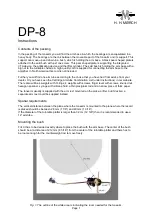
Page 6
Take off the armtube. The accompanying syringe contains about 0.6 ml of silicone fluid. Pull the black
piston out of the lifter cylinder and place it in a completely clean place. Then inject 0.05 ml
but
absolutely no more than 0.1 ml
of the fluid
behind
the lifter handle shaft inside the lifter cylinder.
When doing this the lifter handle must be in "lowered" position (Fig. 8).
When the fluid is injected, the tip of the syringe is "wiped off" on the shaft, and the syringe is pulled up
with a little jerk thereby preventing the fluid from getting in touch with the walls of the lifter cylinder. Do
not put the piston back into the lifter cylinder until the silicone fluid has merged down to the bottom of
the cylinder, and hereafter the piston must
not
be pulled up again, as the silicone fluid would then
easily stick to the walls of the lifter cylinder. If this happens the piston will descend much too slowly.
The silicone fluid can also be used for damping the vertical mode of motion,
something that is rarely
an advantage.
If desired anyway, please request from your supplier a separate document describing
the procedure.
Mounting the cartridge
Fig. 10. A cartridge mounted by using the finger lever and screws.
Using the accompanying finger lever the cartridge can now be mounted on the armtube (Fig. 10). If
possible, use the accompanying aluminum screws. Provided that the tonearm is mounted, so that the
distance from the pivot to the center of the turntable is as indicated in Fig. 1, the position of the stylus
- to obtain correct overhang - should be: with standard armtubes right under the front edge of the
black plane of the armtube - with
PRECISION armtubes 4 mm (5/32”) behind the front edge. Also the
cartridge should be in parallel to the said black plane. Carefully push the terminal jacks of the wires
unto the pins of the cartridge with a pair of tweezers. Do not force them too much and
also see that
you are not squeezing the thin wiring too hard
. Red and green are signal and ground of the right
channel. White and blue are signal and ground of the left channel.
The flange of the armtube having 5 contact pins now is pushed down on the threaded rod on top of
the arm base. It is fastened with the accompanying knurled not, which should be tightened well with
two fingers. Check that the overhang is correct -
18 mm (23/32”) for 9” armtubes - and adjust if
necessary. The easiest way to check that the overhang is correct is to put a ruler on the turntable
platter, so that one of its sides touches the turntable spindle. Then turn the turntable platter, so that
the said side of the ruler points to the center of the knurled nut on top of the armtube. Then the
armtube is moved so that the stylus is brought on line (above the said side of the ruler) with the
direction from the center of the turntable spindle to the center of the said knurled nut. The distance
from the center of the turntable spindle to the stylus (overhang) can be accurately observed by looking
at the scale of the ruler between the stylus and the turntable spindle. Look at right angles to the ruler.
Of course an alignment protractor will help to align more accurately.
Adjusting the tonearm
Using the VTA, adjust the height of the arm base so that the antiskating spring is at level with the
record.










